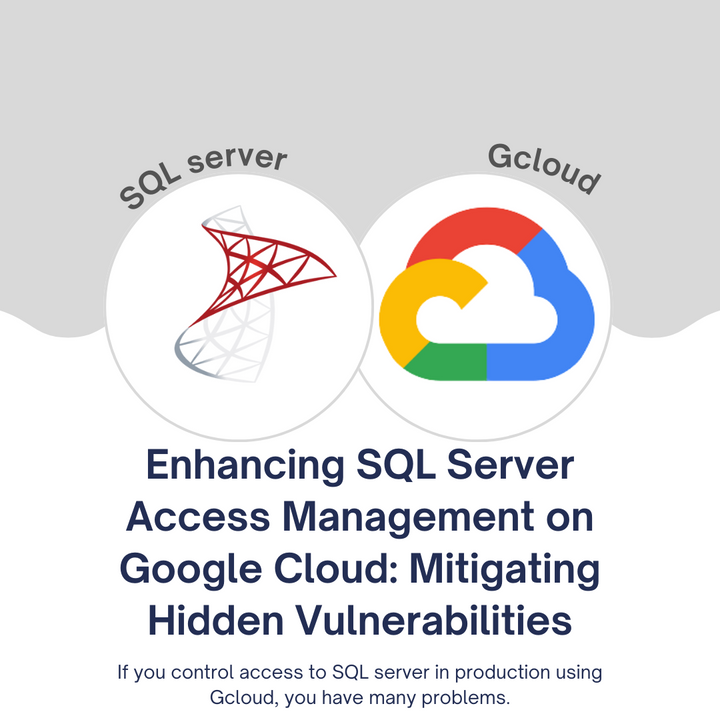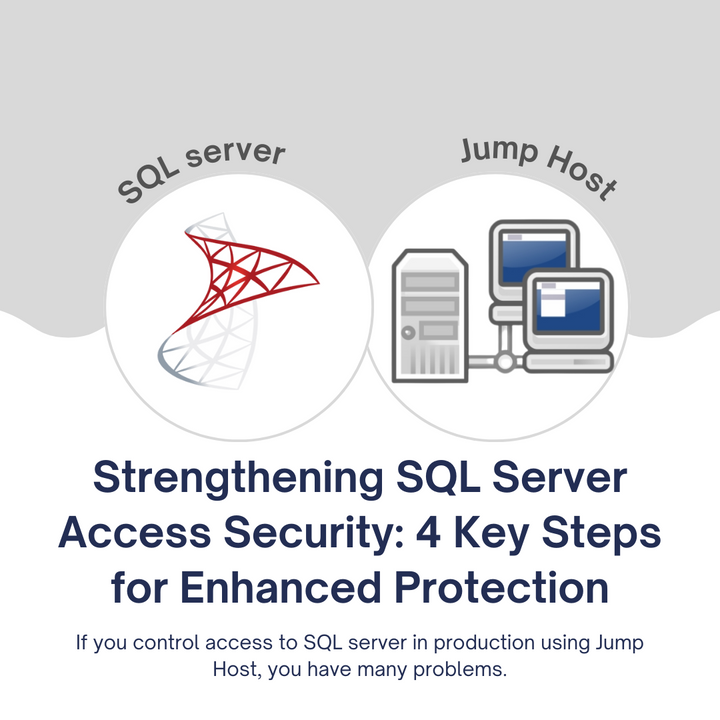8 Steps for Database Administrators to Establish Transparent Access Logs
Introduction
The reason most organizations fall victim to data breaches is because they lack transparent access logs. This happens because many database administrators fail to establish robust access monitoring and control mechanisms, leading to unauthorized access and data breaches. In this post, we're going to walk you through eight essential steps to help database administrators establish transparent access logs.
We're going to cover:
- Defining clear access policies
- Implementing Role-Based Access Control (RBAC)
- Monitoring and auditing database activities
- Encrypting data at rest and in transit
- Ensuring secure authentication and password policies
- Automating access log generation
- Regularly reviewing and analyzing access logs
- Educating and training database users
These steps will not only fortify your database security but also provide a host of benefits, such as preventing data breaches, ensuring data integrity, and maintaining user accountability. By the end of this post, you'll understand how to establish transparent access logs that will help you safeguard your organization's critical data.
Step 1: Define Clear Access Policies
Establishing the Foundation for Transparent Access Logs
Defining clear access policies is the foundational step for establishing transparent access logs. Without a well-documented and communicated set of rules, it becomes challenging to manage who has access to your database and what they can do.
The importance of clear access policies lies in their ability to enhance security. By clearly stating who can access the database and under what conditions, you reduce the risk of unauthorized access.
According to a Verizon Data Breach Investigations Report, a staggering 58% of data breaches involve inside actors with unauthorized access. This statistic underscores the critical importance of access policies in maintaining database security.
The benefit of well-defined access policies is the prevention of unauthorized access, which reduces the risk of data breaches and maintains data integrity. Without such policies in place, you risk exposing sensitive data to the wrong hands.
However, the mistake to avoid here is failing to clearly define access policies. Without a well-established framework, confusion and potential security vulnerabilities can arise.
To implement this step, document and communicate your access policies to all stakeholders, making sure everyone knows what is expected of them. For instance, in a healthcare database, access policies dictate who can view patient records, thus protecting sensitive medical information.
The key takeaway is that well-defined access policies are the first line of defense against data breaches.
Step 2: Implement Role-Based Access Control (RBAC)
Simplifying Access Management for Enhanced Security
Role-Based Access Control (RBAC) is a vital component of transparent access logs, simplifying access management for database administrators. It streamlines the process of granting and revoking access rights, reducing human error and enhancing security.
The importance of RBAC lies in its ability to ensure users have the right level of access. By creating specific roles for users based on their job responsibilities, you prevent overprivileged users from accessing sensitive data.
A survey by the Ponemon Institute found that 56% of organizations experienced a data breach due to inadequate access controls. RBAC can mitigate this risk by tightly controlling access permissions.
The benefit of RBAC is that it prevents unauthorized access, thus protecting your data from misuse or theft. Allowing users excessive access can lead to data leaks or unintended changes, which can be costly and damaging.
To implement RBAC, create specific roles based on job functions. In an e-commerce database, for instance, customer service representatives might have read-only access to prevent unauthorized changes to product listings.
The key takeaway here is that RBAC minimizes security risks by restricting access to necessary functions, maintaining a higher level of security.
Step 3: Monitor and Audit Database Activities
Continuous Vigilance for Unusual Patterns
Continuous monitoring and auditing are vital for maintaining transparent access logs. It's not enough to define access policies and roles; you must actively watch who accesses the system and what they do.
The importance of monitoring and auditing lies in their ability to provide insights into database activities. It helps you track who is accessing your data and what actions they perform, allowing for timely detection of suspicious activities.
A report by Cybersecurity Insiders indicates that 77% of organizations lack proper visibility into database activity. This lack of visibility can result in delayed detection of security incidents.
The benefit of monitoring and auditing is that they can identify unusual patterns and potential security breaches. By continuously reviewing access logs, you can quickly respond to threats, minimizing damage and preventing data breaches.
The mistake to avoid here is neglecting monitoring and auditing. Failure to do so can lead to missed warning signs of a data breach, leaving your database vulnerable.
To implement this step, use real-time monitoring tools and conduct regular audit reviews. For example, in a financial institution's database, monitoring can detect an unusual login pattern, which can prevent potential data theft.
The key takeaway is that timely monitoring and audits enhance database security by quickly identifying and addressing threats.
Step 4: Encrypt Data at Rest and in Transit
Shielding Data from Unauthorized Access
Data encryption is a fundamental step in protecting sensitive information. It safeguards data from unauthorized access during storage and transmission, ensuring that even if an intruder gains access, they cannot decipher the data.
The importance of encryption lies in its ability to add an extra layer of security. Strong encryption algorithms render data useless to unauthorized parties, thus maintaining data confidentiality.
A study by IBM Security found that data breaches cost an average of $4.24 million. Data breaches can lead to severe financial consequences and damage to an organization's reputation, making encryption essential.
The benefit of encryption is that it safeguards data, maintaining the confidentiality and integrity of sensitive information. Without encryption, data can be exposed in case of a breach, leading to significant security and financial risks.
To implement this step, use strong encryption algorithms for both data at rest and in transit. For example, a cloud-based database for a legal firm might encrypt sensitive client documents, ensuring client confidentiality.
The key takeaway is that encryption is essential for data protection, preventing unauthorized access and safeguarding your organization's reputation.
Step 5: Ensure Secure Authentication and Password Policies
Building a Strong Barrier Against Unauthorized Access
Strong authentication and password policies are vital for secure database access. They prevent unauthorized users from gaining access to the database, which is crucial for maintaining data integrity.
The importance of secure authentication and password policies lies in their ability to protect your database from unauthorized access. They reduce the risk of data breaches by ensuring that only authorized users can log in.
According to Verizon's Data Breach Investigations Report, 81% of data breaches involve weak or stolen passwords. This statistic underscores the critical role of authentication and password policies in preventing security incidents.
The benefit of these policies is that they mitigate the risk of unauthorized access, ensuring that only individuals with the proper credentials can access the database. Allowing weak passwords or lax authentication can lead to compromised accounts, risking data leaks and breaches.
To implement this step, enforce complex password requirements and implement multi-factor authentication. For instance, a corporate database might require employees to use complex passwords and a fingerprint scan for access.
The key takeaway is that secure authentication and strong password policies are essential for data protection, creating a robust barrier against unauthorized access.
Step 6: Automate Access Log Generation
Streamlining the Process for Continuous Monitoring
Automation simplifies access log generation and maintenance, ensuring that you have consistent and real-time log data. This step is crucial for improving security incident response and maintaining transparent access logs.
The importance of automation in access log generation is that it provides immediate insights into user activities. It helps ensure that logs are consistently generated, making it easier to detect unauthorized access or unusual patterns.
A report by Help Net Security indicates that it takes an average of 280 days to identify and contain a data breach. Automation can significantly reduce this time by providing real-time data on user activities.
The benefit of automation is that it accelerates incident response and enhances database security. By automating access log generation, you can quickly detect and respond to security threats.
The mistake to avoid here is manual log generation, which can lead to delays and incomplete data. Manual processes can be error-prone and unreliable.
To implement this step, utilize tools and scripts for automated log generation. For example, a retail database might automatically generate logs for every transaction, helping detect and prevent fraud.
The key takeaway is that automation streamlines the process of log generation and enhances security incident response, providing more robust and transparent access logs.
Step 7: Regularly Review and Analyze Access Logs
Proactive Security Measures Through Regular Reviews
Periodic review and analysis of access logs are essential for identifying anomalies and security threats. It's not enough to generate logs; you must actively review and analyze them to ensure database security.
The importance of regular log review lies in its ability to detect unusual patterns and potential security breaches. By analyzing access logs, you can identify suspicious activities and take proactive measures to protect your database.
The 2021 Cost of Insider Threats Report found that the average cost of an insider threat incident is $2.79 million. Regular log review and analysis can help prevent costly insider threats and maintain data integrity.
The benefit of this step is that it provides proactive security measures by detecting potential threats before they escalate. It ensures that your database remains secure and that any anomalies are quickly addressed.
The mistake to avoid here is neglecting log analysis. Failing to review and analyze access logs can lead to missed warning signs of a data breach, leaving your database vulnerable.
To implement this step, set up automated log analysis tools and establish a routine for log review. For example, an educational institution's database revealed an unusual number of login attempts through analysis, leading to the detection of a brute force attack.
The key takeaway is that regular log review and analysis are crucial for proactive security measures, allowing you to stay one step ahead of potential threats.
Step 8: Educate and Train Database Users
Empowering Users for Enhanced Security
Educating and training database users is a proactive measure for transparent access logs. It ensures that users understand their roles and responsibilities in maintaining database security.
The importance of user education lies in its ability to reduce the risk of security incidents caused by employee error or negligence. By educating users, you empower them to recognize and report suspicious activities, enhancing overall security.
A study by Shred-it found that 47% of data breaches are caused by employee error or negligence. User education can significantly reduce this risk by making users more security-conscious.
The benefit of this step is that educated users are an integral part of a robust database security strategy. They become an extra layer of defense against potential threats.
The mistake to avoid here is neglecting user education. Failing to educate and train users can result in users inadvertently causing security incidents due to their lack of awareness.
To implement this step, conduct regular security awareness training sessions. For example, a government agency provides training to its employees to recognize and report suspicious database activities, empowering them to be vigilant.
The key takeaway is that educated users are an essential component of transparent access logs, providing an additional layer of security and vigilance.
Conclusion
Establishing transparent access logs is paramount for safeguarding your organization's critical data. By defining clear access policies, implementing RBAC, monitoring and auditing database activities, encrypting data, ensuring secure authentication and password policies, automating log generation, regularly reviewing logs, and educating users, you can create a robust defense against data breaches and security incidents.
These steps not only enhance security but also promote data integrity, maintain user accountability, and protect your organization's reputation. It's time to take these essential measures to secure your database and prevent costly security incidents.



